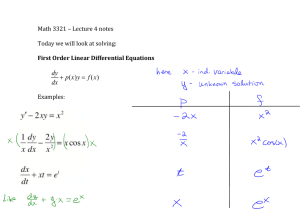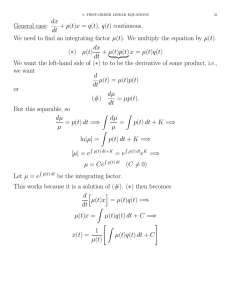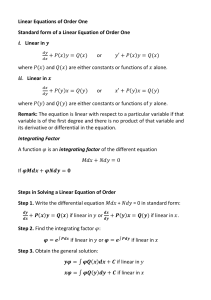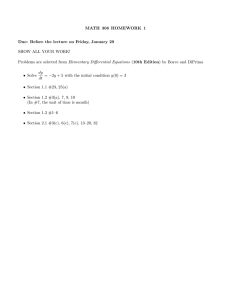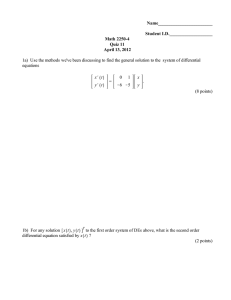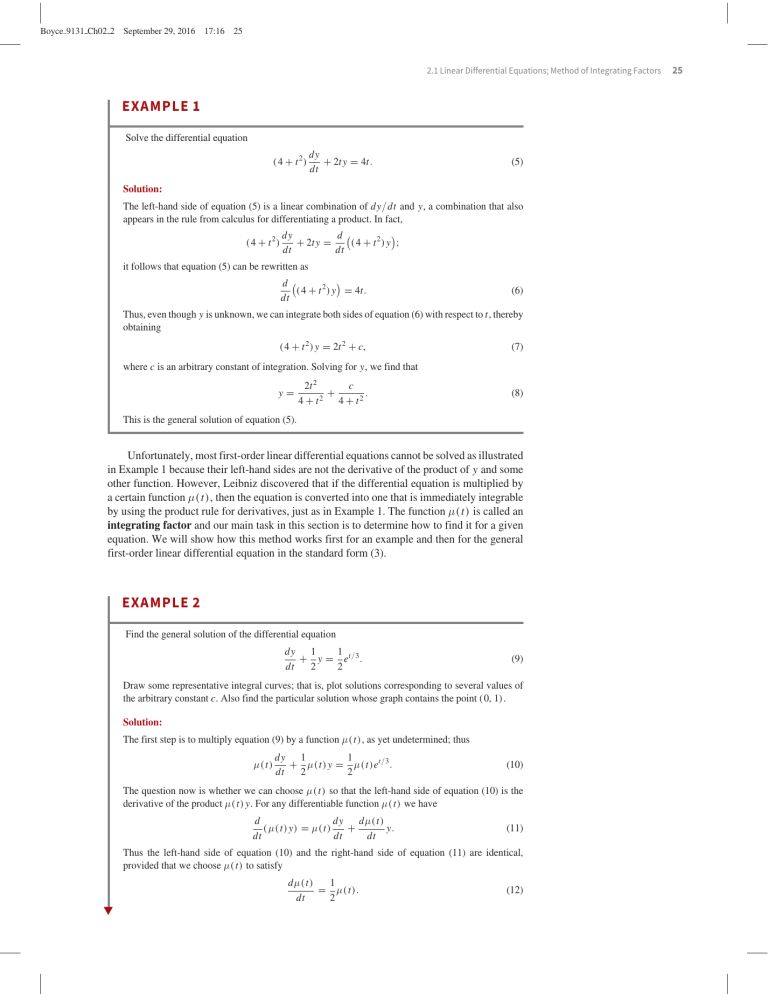
Boyce 9131 Ch02 2 September 29, 2016 17:16 25 2.1 Linear Differential Equations; Method of Integrating Factors EXAMPLE 1 Solve the differential equation ( 4 + t 2) dy + 2t y = 4t. dt (5) Solution: The left-hand side of equation (5) is a linear combination of dy/dt and y, a combination that also appears in the rule from calculus for differentiating a product. In fact, ( 4 + t 2) dy d ( 4 + t 2) y ; + 2t y = dt dt it follows that equation (5) can be rewritten as d ( 4 + t 2 ) y = 4t. dt (6) Thus, even though y is unknown, we can integrate both sides of equation (6) with respect to t, thereby obtaining ( 4 + t 2 ) y = 2t 2 + c, (7) where c is an arbitrary constant of integration. Solving for y, we find that y= c 2t 2 + . 2 4+t 4 + t2 (8) This is the general solution of equation (5). Unfortunately, most first-order linear differential equations cannot be solved as illustrated in Example 1 because their left-hand sides are not the derivative of the product of y and some other function. However, Leibniz discovered that if the differential equation is multiplied by a certain function μ ( t) , then the equation is converted into one that is immediately integrable by using the product rule for derivatives, just as in Example 1. The function μ ( t) is called an integrating factor and our main task in this section is to determine how to find it for a given equation. We will show how this method works first for an example and then for the general first-order linear differential equation in the standard form (3). EXAMPLE 2 Find the general solution of the differential equation 1 1 dy + y = et/3 . dt 2 2 (9) Draw some representative integral curves; that is, plot solutions corresponding to several values of the arbitrary constant c. Also find the particular solution whose graph contains the point ( 0, 1) . Solution: The first step is to multiply equation (9) by a function μ ( t) , as yet undetermined; thus μ ( t) dy 1 1 + μ ( t) y = μ ( t) et/3 . dt 2 2 (10) The question now is whether we can choose μ ( t) so that the left-hand side of equation (10) is the derivative of the product μ ( t) y. For any differentiable function μ ( t) we have dy dμ ( t) d ( μ ( t) y) = μ ( t) + y. dt dt dt (11) Thus the left-hand side of equation (10) and the right-hand side of equation (11) are identical, provided that we choose μ ( t) to satisfy dμ ( t) 1 = μ ( t) . dt 2 ▼ (12) 25 Boyce 9131 Ch02 2 26 September 29, 2016 17:16 26 CHAPTER 2 First-Order Differential Equations ▼ Our search for an integrating factor will be successful if we can find a solution of equation (12). Perhaps you can readily identify a function that satisfies equation (12): What well-known function from calculus has a derivative that is equal to one-half times the original function? More systematically, rewrite equation (12) as 1 dμ ( t) 1 = , μ ( t) dt 2 which is equivalent to 1 d ln |μ ( t) | = . dt 2 (13) Then it follows that ln |μ ( t) | = 1 t + C, 2 or μ ( t) = cet/2 . (14) The function μ ( t) given by equation (14) is an integrating factor for equation (9). Since we do not need the most general integrating factor, we will choose c to be 1 in equation (14) and use μ ( t) = et/2 . Now we return to equation (9), multiply it by the integrating factor et/2 , and obtain et/2 dy 1 1 + et/2 y = e5t/6 . dt 2 2 (15) By the choice we have made of the integrating factor, the left-hand side of equation (15) is the derivative of et/2 y, so that equation (15) becomes 1 d t/2 ( e y) = e5t/6 . (16) dt 2 By integrating both sides of equation (16), we obtain 3 et/2 y = e5t/6 + c, 5 (17) where c is an arbitrary constant. Finally, on solving equation (17) for y, we have the general solution of equation (9), namely, 3 y = et/3 + ce−t/2 . (18) 5 To find the solution passing through the point ( 0, 1) , we set t = 0 and y = 1 in equation (18), obtaining 1 = 3/5 + c. Thus c = 2/5, and the desired solution is 3 2 y = et/3 + e−t/2 . (19) 5 5 Figure 2.1.1 includes the graphs of equation (18) for several values of c with a direction field in the background. The solution satisfying y( 0) = 1 is shown by the green curve. y 4 3 2 1 1 2 3 4 5 6 t –1 –2 1 1 FIGURE 2.1.1 Direction field and integral curves of y + 2 y = 2 et/3 ; the green curve passes through the point ( 0, 1) . Boyce 9131 Ch02 2 September 29, 2016 17:16 27 2.1 Linear Differential Equations; Method of Integrating Factors Let us now extend the method of integrating factors to equations of the form dy + ay = g( t) , dt (20) where a is a given constant and g( t) is a given function. Proceeding as in Example 2, we find that the integrating factor μ ( t) must satisfy dμ = aμ , dt (21) rather than equation (12). Thus the integrating factor is μ ( t) = eat . Multiplying equation (20) by μ ( t) , we obtain eat dy + aeat y = eat g( t) , dt or d at ( e y) = eat g( t) . dt By integrating both sides of equation (22), we find that at e y = eat g( t) dt + c, (22) (23) where c is an arbitrary constant. For many simple functions g( t) , we can evaluate the integral in equation (23) and express the solution y in terms of elementary functions, as in Example 2. However, for more complicated functions g( t) , it is necessary to leave the solution in integral form. In this case t y = e−at eas g( s) ds + ce−at . (24) t0 Note that in equation (24) we have used s to denote the integration variable to distinguish it from the independent variable t, and we have chosen some convenient value t0 as the lower limit of integration. (See Theorem 2.4.1.) The choice of t0 determines the specific value of the constant c but does not change the solution. For example, plugging t = t0 into the solution formula (24) shows that c = y( t0 ) eat0 . EXAMPLE 3 Find the general solution of the differential equation dy − 2y = 4 − t dt (25) and plot the graphs of several solutions. Discuss the behavior of solutions as t → ∞. Solution: Equation (25) is of the form (20) with a = −2; therefore, the integrating factor is μ ( t) = e−2t . Multiplying the differential equation (25) by μ ( t) , we obtain e−2t dy − 2e−2t y = 4e−2t − te−2t , dt or d −2t e y = 4e−2t − te−2t . dt Then, by integrating both sides of this equation, we have (26) 1 1 e−2t y = −2e−2t + te−2t + e−2t + c, 2 4 where we have used integration by parts on the last term in equation (26). Thus the general solution of equation (25) is ▼ 7 1 y = − + t + ce2t . 4 2 (27) 27 Boyce 9131 Ch02 2 28 September 29, 2016 17:16 28 CHAPTER 2 First-Order Differential Equations ▼ Figure 2.1.2 shows the direction field and graphs of the solution (27) for several values of c. The behavior of the solution for large values of t is determined by the term ce2t . If c = 0, then the solution grows exponentially large in magnitude, with the same sign as c itself. Thus the solutions diverge as t becomes large. The boundary between solutions that ultimately grow positively and those that ultimately grow negatively occurs when c = 0. If we substitute c = 0 into equation (27) and then set t = 0, we find that y = −7/4 is the separation point on the y-axis. Note that for this initial value, 7 1 the solution is y = − + t; it grows positively, but linearly rather than exponentially. 4 2 y 0.5 1 1.5 2 t –1 –2 –3 –4 FIGURE 2.1.2 Direction field and integral curves of y − 2y = 4 − t. Now we return to the general first-order linear differential equation (3) dy + p( t) y = g( t) , dt where p and g are given functions. To determine an appropriate integrating factor, we multiply equation (3) by an as yet undetermined function μ ( t) , obtaining μ ( t) dy + p( t) μ ( t) y = μ ( t) g( t) . dt (28) Following the same line of development as in Example 2, we see that the left-hand side of equation (28) is the derivative of the product μ ( t) y, provided that μ ( t) satisfies the equation dμ ( t) (29) = p( t) μ ( t) . dt If we assume temporarily that μ ( t) is positive, then we have 1 dμ ( t) = p( t) , μ ( t) dt and consequently ln |μ ( t) | = p( t) dt + k. By choosing the arbitrary constant k to be zero, we obtain the simplest possible function for μ , namely, μ ( t) = exp p( t) dt. (30) Note that μ ( t) is positive for all t, as we assumed. Returning to equation (28), we have d ( μ ( t) y) = μ ( t) g( t) . dt Hence (31) μ ( t) y = μ ( t) g( t) dt + c, (32) Boyce 9131 Ch02 2 September 29, 2016 17:16 29 2.1 Linear Differential Equations; Method of Integrating Factors where c is an arbitrary constant. Sometimes the integral in equation (32) can be evaluated in terms of elementary functions. However, in general this is not possible, so the general solution of equation (3) is t 1 y= μ ( s) g( s) ds + c , (33) μ ( t) t0 where again t0 is some convenient lower limit of integration. Observe that equation (33) involves two integrations, one to obtain μ ( t) from equation (30) and the other to determine y from equation (33). EXAMPLE 4 Solve the initial value problem t y + 2y = 4t 2 , y( 1) = 2. (34) (35) Solution: In order to determine p( t) and g( t) correctly, we must first rewrite equation (34) in the standard form (3). Thus we have 2 (36) y + y = 4t, t so p( t) = 2/ t and g( t) = 4t. To solve equation (36), we first compute the integrating factor μ ( t) : 2 dt t μ ( t) = exp = e2 ln |t| = t 2 . On multiplying equation (36) by μ ( t) = t 2 , we obtain t 2 y + 2t y = ( t 2 y) = 4t 3 , and therefore t y= 4t 3 dt = t 4 + c, 2 where c is an arbitrary constant. It follows that, for t > 0, c (37) y = t2 + 2 t is the general solution of equation (34). Integral curves of equation (34) for several values of c are shown in Figure 2.1.3. To satisfy initial condition (35), set t = 1 and y = 2 in equation (37): 2 = 1 + c, so c = 1; thus y = t2 + 1 , t2 t>0 (38) is the solution of the initial value problem (24), (25). This solution is shown by the green curve in Figure 2.1.3. Note that it becomes unbounded and is asymptotic to the positive y-axis as t → 0 from the right. This is the effect of the infinite discontinuity in the coefficient p( t) at the origin. It is important to note that while the function y = t 2 + 1/ t 2 for t < 0 is part of the general solution of equation (34), it is not part of the solution of this initial value problem. This is the first example in which the solution fails to exist for some values of t. Again, this is due to the infinite discontinuity in p( t) at t = 0, which restricts the solution to the interval 0 < t < ∞. Looking again at Figure 2.1.3, we see that some solutions (those for which c > 0) are asymptotic to the positive y-axis as t → 0 from the right, while other solutions (for which c < 0) are asymptotic to the negative y-axis. If we generalize the initial condition (35) to y( 1) = y0 , (39) then c = y0 − 1 and the solution (38) becomes y = t2 + y0 − 1 t2 , t>0 (40) Note that when y0 = 1, so c = 0, the solution is y = t 2 , which remains bounded and differentiable even at t = 0. (This is the red curve in Figure 2.1.3.) ▼ 29 Boyce 9131 Ch02 2 30 September 29, 2016 17:16 30 CHAPTER 2 First-Order Differential Equations ▼ As in Example 3, this is another instance where there is a critical initial value, namely, y0 = 1, that separates solutions that behave in one way from others that behave quite differently. y 3 2 (1, 2) 1 –1 1 t –1 FIGURE 2.1.3 Integral curves of the differential equation t y + 2y = 4t 2 ; the green curve is the particular solution with y( 1) = 2. The red curve is the particular solution with y( 1) = 1. EXAMPLE 5 Solve the initial value problem 2y + t y = 2, (41) y( 0) = 1. (42) Solution: To convert the differential equation (41) to the standard form (3), we must divide equation (41) by 2, obtaining t y + y = 1. (43) 2 Thus p( t) = t/2, and the integrating factor is μ ( t) = exp( t 2 /4) . Then multiply equation (43) by μ ( t) , so that t 2 2 2 et /4 y + et /4 y = et /4 . (44) 2 The left-hand side of equation (44) is the derivative of et equation (44), we obtain et 2 /4 y= et 2 /4 2 /4 y, so by integrating both sides of dt + c. (45) The integral on the right-hand side of equation (45) cannot be evaluated in terms of the usual elementary functions, so we leave the integral unevaluated. By choosing the lower limit of integration as the initial point t = 0, we can replace equation (45) by et 2 /4 t y= es 2 /4 ds + c, (46) 0 where c is an arbitrary constant. It then follows that the general solution y of equation (41) is given by y=e −t 2 /4 t es 2 /4 ds + ce−t 2 /4 . (47) 0 To determine the particular solution that satisfies the initial condition (42), set t = 0 and y = 1 in equation (47): 1=e 0 0 0 = 0 + c, ▼ so c = 1. e−s 2 /4 ds + ce0 Boyce 9131 Ch02 2 September 29, 2016 17:16 31 2.1 Linear Differential Equations; Method of Integrating Factors ▼ 31 The main purpose of this example is to illustrate that sometimes the solution must be left in terms of an integral. This is usually at most a slight inconvenience, rather than a serious obstacle. For a given value of t, the integral in equation (47) is a definite integral and can be approximated to any desired degree of accuracy by using readily available numerical integrators. By repeating this process for many values of t and plotting the results, you can obtain a graph of a solution. Alternatively, you can use a numerical approximation method, such as those discussed in Chapter 8, that proceed directly from the differential equation and need no expression for the solution. Software packages such as Maple, Mathematica, MATLAB and Sage readily execute such procedures and produce graphs of solutions of differential equations. Figure 2.1.4 displays graphs of the solution (47) for several values of c. The particular solution satisfying the initial condition y( 0) = 1 is shown in black. From the figure it may be plausible to conjecture that all solutions approach a limit as t → ∞. The limit can also be found analytically (see Problem 22). y 3 2 1 1 2 3 5 4 6 t –1 –2 –3 FIGURE 2.1.4 Integral curves of 2y + t y = 2; the green curve is the particular solution satisfying the initial condition y( 0) = 1. Problems In each of Problems 1 through 8: G a. Draw a direction field for the given differential equation. b. Based on an inspection of the direction field, describe how solutions behave for large t. c. Find the general solution of the given differential equation, and use it to determine how solutions behave as t → ∞. 1. y + 3y = t + e−2t 2. y − 2y = t 2 e2t 3. y + y = te−t + 1 1 t y − 2y = 3et 4. y + y = 3 cos( 2t) , t>0 5. 6. t y − y = t 2 e−t , t > 0 7. y + y = 5 sin( 2t) 8. 2y + y = 3t 2 In each of Problems 9 through 12, find the solution of the given initial value problem. 9. y − y = 2te2t , y( 0) = 1 10. y + 2y = te−2t , y( 1) = 0 2 cos t , y( π ) = 0, t > 0 t t2 t y + ( t + 1) y = t, y( ln 2) = 1, t > 0 11. y + y = 12. In each of Problems 13 and 14: G a. Draw a direction field for the given differential equation. How do solutions appear to behave as t becomes large? Does the behavior depend on the choice of the initial value a? Let a0 be the value of a for which the transition from one type of behavior to another occurs. Estimate the value of a0 . b. Solve the initial value problem and find the critical value a0 exactly. c. Describe the behavior of the solution corresponding to the initial value a0 . 1 13. y − y = 2 cos t, y( 0) = a 2 14. 3y − 2y = e−π t/2 , y( 0) = a Boyce 9131 Ch02 2 32 September 29, 2016 17:16 32 CHAPTER 2 First-Order Differential Equations In each of Problems 15 and 16: G a. Draw a direction field for the given differential equation. How do solutions appear to behave as t → 0? Does the behavior depend on the choice of the initial value a? Let a0 be the critical value of a, that is, the initial value such that the solutions for a < a0 and the solutions for a > a0 have different behaviors as t → ∞. Estimate the value of a0 . b. Solve the initial value problem and find the critical value a0 exactly. c. Describe the behavior of the solution corresponding to the initial value a0 . 15. t y + ( t + 1) y = 2te−t , y( 1) = a, t > 0 16. ( sin t) y + ( cos t) y = et , y( 1) = a, 0 < t < π G 17. Consider the initial value problem 1 y = 2 cos t, y( 0) = −1. 2 Find the coordinates of the first local maximum point of the solution for t > 0. y + N 18. Consider the initial value problem y + 2 1 y = 1 − t, 3 2 term in the solution (47) is indeterminate with form 0 · ∞. Then, use l’Hôpital’s rule to compute the limit as t → ∞. 23. Show that if a and λ are positive constants, and b is any real number, then every solution of the equation y + ay = be−λt has the property that y → 0 as t → ∞. Hint: Consider the cases a = λ and a = λ separately. In each of Problems 24 through 27, construct a first-order linear differential equation whose solutions have the required behavior as t → ∞. Then solve your equation and confirm that the solutions do indeed have the specified property. 24. 25. 26. 27. 28. All solutions have the limit 3 as t → ∞. All solutions are asymptotic to the line y = 3 − t as t → ∞. All solutions are asymptotic to the line y = 2t − 5 as t → ∞. All solutions approach the curve y = 4 − t 2 as t → ∞. Variation of Parameters. Consider the following method of solving the general linear equation of first order: y + p( t) y = g( t) . y( 0) = y0 . Find the value of y0 for which the solution touches, but does not cross, the t-axis. (48) a. If g( t) = 0 for all t, show that the solution is y = A exp − p( t) dt , (49) 19. Consider the initial value problem y + 1 y = 3 + 2 cos( 2t) , 4 y( 0) = 0. where A is a constant. b. If g( t) is not everywhere zero, assume that the solution of equation (48) is of the form a. Find the solution of this initial value problem and describe its behavior for large t. N b. Determine the value of t for which the solution first intersects the line y = 12. 20. Find the value of y0 for which the solution of the initial value problem y − y = 1 + 3 sin t, remains finite as t → ∞. 3 y = 3t + 2et , 2 y( 0) = y0 . Find the value of y0 that separates solutions that grow positively as t → ∞ from those that grow negatively. How does the solution that corresponds to this critical value of y0 behave as t → ∞? 22. Show that all solutions of 2y + t y = 2 [equation (41) of the text] approach a limit as t → ∞, and find the limiting value. Hint: Consider the general solution, equation (47). Show that the first p( t) dt , (50) where A is now a function of t. By substituting for y in the given differential equation, show that A( t) must satisfy the condition A ( t) = g( t) exp y( 0) = y0 21. Consider the initial value problem y − y = A( t) exp − p( t) dt . (51) c. Find A( t) from equation (51). Then substitute for A( t) in equation (50) and determine y. Verify that the solution obtained in this manner agrees with that of equation (33) in the text. This technique is known as the method of variation of parameters; it is discussed in detail in Section 3.6 in connection with secondorder linear equations. In each of Problems 29 and 30, use the method of Problem 28 to solve the given differential equation. 29. y − 2y = t 2 e2t 1 t 30. y + y = cos( 2t) , t>0
